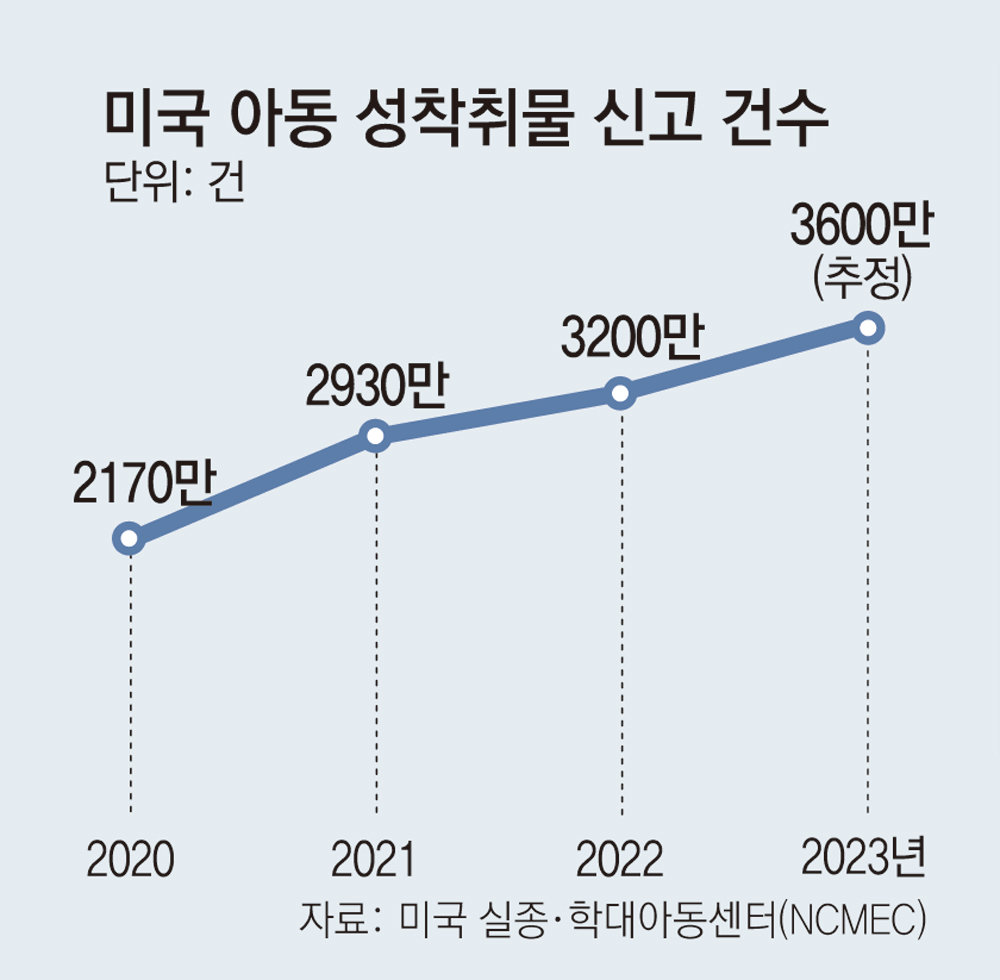The highest number of users in history using SNS such as Facebook-X
Online sexual exploitation doubles in one year
Big tech monitoring is not done properly
Legislation is also aesthetic due to privacy reasons.
The number of reports of online child sexual exploitation filed with the National Center for Missing and Exploited Children (NCMEC) exceeded 36 million last year, hitting an all-time high. In fact, most of the child sexual exploitation material was spread on major social media such as Facebook and X (formerly Twitter). Last year, regulatory bills were proposed in the U.S. Congress, including allowing children who are victims of sexual exploitation to sue social media companies. However, legislation has been sluggish due to opposition due to concerns over infringement of personal information. First of all, the US Senate plans to appoint CEOs of big tech companies to the hearing stage on the 31st.

The Washington Post (WP) reported on the 29th, “The number of reports of online child sexual exploitation compiled by NCMEC, a private, non-profit organization, has increased significantly from 32 million in 2022 to 36 million last year.” The number of cases increased from 21.7 million in 2020 to 29.3 million in 2021, and has continued to increase sharply since then. Despite all efforts made by the government and related private organizations, the number of sexually exploitative materials shows no sign of decreasing.
The paradigm in which child sexual exploitation material is produced and distributed is also changing. Carrie Goldberg, a lawyer specializing in sex crimes, said, “In the past, videos were produced secretly and exchanged secretly in closed online spaces, but these days, as production methods have become simpler, children are making illegal videos directly with their smartphones.” According to NCMEC, sexually exploitative materials are produced and distributed indiscriminately even in everyday life, and at least twelve victims committed suicide last year.
Recently, ‘online sexual enticement’, which involves approaching a person by pretending to be a friend or acquaintance through social media or messaging apps and then luring them with money and requesting explicit photos and videos, has also become a serious issue. Although the proportion of related reports is still low, the increase is extremely fast. It more than doubled in one year from about 80,000 cases in 2022 to 186,000 cases last year. Additionally, many of the sexually exploitative materials were created by people with ‘legal access to children’ such as parents, relatives, babysitters, and neighbors.
More than 90% of child sexual exploitation materials reported to NCMEC were uploaded from countries other than the United States, but most were distributed through social media platforms such as Facebook, Snapchat, and TikTok.
There are many voices calling for active regulation of social media and video platforms to prevent damage to child sexual exploitation. There are bound to be limits to relying only on crackdowns on producers or voluntary measures by platform companies.
In May of last year, bills were introduced in the U.S. Senate to hold companies more accountable, including allowing children who are victims of sexual exploitation to sue social platforms. However, legislative activities have not progressed since then. This is due to opposition that the bill could infringe on the personal information of general users or even lead to the deletion of legitimate posts. WP expressed concern, saying, “Prevention of child sexual exploitation is a rare topic that can unite the political world, but technological advancements are rapidly outpacing the pace of regulation.”
Some point out that companies that have voluntarily strengthened monitoring appear to be ‘hotbeds of child sexual exploitation’. The relatively active Mehta reported that more than 21 million reports were received on Facebook in 2022. This is more than half of all reports received. On the other hand, the number of reports of
The Senate Legislation and Judiciary Committee summoned Big Tech CEOs as witnesses at a hearing to discuss regulation of child sexual exploitation materials on the 31st. However, Mary Ann Franks, a professor at George Washington University Law School, pointed out, “Nothing can be changed through rhetorical criticism from politicians.” Attorney Goldberg also agreed, saying, “The only way to pressure companies to change is to make them pay for the damage through legislation.”
Source: Donga
Mark Jones is a world traveler and journalist for News Rebeat. With a curious mind and a love of adventure, Mark brings a unique perspective to the latest global events and provides in-depth and thought-provoking coverage of the world at large.